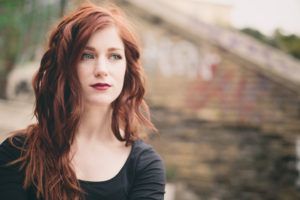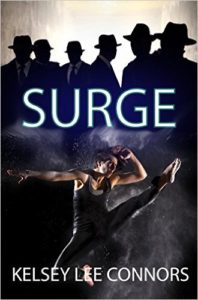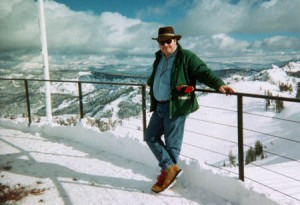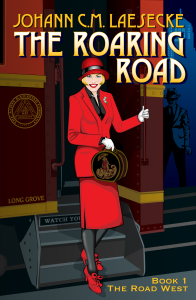The definition of “historical fiction” is blurry at best, and never more so than when people introduce a fantasy element to a specific time and place (see the interview I did with Lavinia Collins for an Arthurian example.) Heck, even Star Trek did an episode with Al Capone. History is always blended with fiction – take Game of Thrones. It’s very obviously set in medieval times with knights and swords and castles, but look closer and there will be nothing that is actually true to historical fact. Similarly, Lord of the Rings is set in a time of magic and wizards and kings and queens, but when exactly is it set? We can read all about Aragorn and Gandalf and Bilbo, but then we see the world is entirely fictional. It’s only based on history. It makes sense to do this – authors can borrow different styles from different eras, creating an amalgamation of different historical periods.
And why wouldn’t they do this? Somewhere like 1920’s Chicago was an amazing period. In fact, it serves as part of the backdrop for my own book, The Count of the Sahara. Why tart it up? Because it’s fun. Kelsey Lee Connors has written a dystopian fantasy for young adults that is set in a time recognizable as Chicago in the ’20s, but with a twist.

First, give us the Kelsey Lee Connors story…
I was born in Chicago, Illinois, and I’ve been writing since I was 14 years old. At University I studied Classical Studies, with a minor in Anthropology, and after two years work experience I decided to move to Rome, Italy to pursue my career in Roman history and an MA in Arts Management. Now I’m 25, teaching English as a foreign language while I finish my masters’ at The American University in Rome, and excited to finish the second novel in my series. Some fun facts about me: I’m an artist, a crazy cat lady, I love fantasy of all sorts, and I cosplay Ygritte from Game of Thrones every year at C2E2, Chicago’s Comic Con.
I’d also be remiss if I didn’t mention that you and I share a publisher, “The Book Folks” out of London. Between you, me, and Lou Holly, Erik must be tempted to open a Chicago office.
In a nutshell, what’s the book about?
The book is about Chicago in the 1920’s, which is ruled by a faceless, high-tech Corporation slowly sucking the life from its citizens. The story is told through the perspective of 16-year-old Evelyn O’Donnell, whose father dies of a sudden car-accident near their home. Or so they think. After his death, the now dry Pub he worked day and night to keep running for their neighborhood, is about to go under. Evelyn teams up with her brother’s mysterious new friend (Dante Malachi), despite completely despising him, in order to get the funds to save it. The unlikely pair take to the speakeasies to gamble it back by playing Black Jack.
But Chicago is changing, and so is Evelyn. Each day a strange power she can’t seem to control sends sparks of electricity flying from her fingertips. News of her father’s life before his death grows darker with each turn around the grapevine. And there are rumors of the Corporation’s electrical plants turning the alive…into the undead.
When you’re writing fantasy based on history….. where do you decide how much of each….. how much does real history impact that balance? I mean, the mob was tough but they weren’t creating electricity out of bodies!
I tried to incorporate as much historical accuracy as I could when I wrote SURGE. I like to think of The Corporation as a tick on the skin- Chicago is more or less in the same historical period as it was in the true version of history, but it has a sort of infestation of technology feeding off it.
I was woefully ignorant about the 20’s as a period before I started research, which is why I went in this direction. I think most people have an idea very different from what it actually was like. Interestingly, the biggest delusions about the era are pertaining to women, crime and, of course, fashion. I could go on for hours about the actual length of a flapper’s dress (much longer than we see in modern costumes) or the modern fad of wearing suspenders (back then were considered undergarments, not for show). But, at the end of the day, I hugely enjoyed the research aspect of writing!
What is it about that time period or character that intrigued you and motivated you to write about it?
Back in college, I did an internship in the Collections Department at the Hellenic Museum in Chicago where I was handling a huge amount of artifacts from Greek immigrants in the Prohibition era. I’ve always loved the period, but this really planted the seed of inspiration. I really wanted to write another book about electric control, and one particularly cold and rainy day I was coming up from

the L train off UIC/Halsted to the museum and the ideas collided.
Of course, Evelyn came along because I imagined what it would be like to be in the shoes of those immigrants. She and her brother are second generation Irish immigrants, a salute to my own heritage. In Paris, there was a similar, one would argue better, period of art and exploration and that’s in part what inspired Dante’s origins. I like to think of him wandering Parisian streets heckling Fitzgerald and Hemingway, scotch glass in hand.
Without giving away spoilers, what’s your favorite scene or event in the book?
Without a doubt, when Evelyn enters a speakeasy for the first time. I had imagined the scene so many times in my head that when I came to write it down, I got the worst writer’s block of my life. It ended up being the last scene I wrote!
It’s an actual real, historical place called the Green Mill in Chicago, which I’ve visited many times. It’s famous for being Al Capone’s (or Capuzzi, in SURGE) hangout and there are still the original tunnels below it that they used for importing liquor and escaping from the fuzz!
Living in Chicago, I know the Green Mill well. It’s easy to get sucked into the past there. Where can people learn more about you and your work?
Website: https://kelseylconnors.wordpress.com/
SURGE on Facebook: www.facebook.com/kelseyleeconnors
Amazon Author: http://www.amazon.com/Kelsey-Connors/e/B01FWPE2MY
Goodreads: https://www.goodreads.com/kelseyleeconnors
Also, you can reach me on my Instagram to see what life in Rome is like, and to see special instagram only book updates! https://www.instagram.com/kelseyleeconnors/


